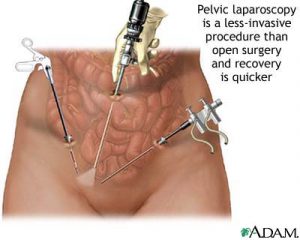Definition
Endometriosis is a condition in which the tissue that behaves like the cells lining the uterus (endometrium) grows in other areas of the body, causing pain, irregular bleeding, and possible infertility.
The tissue growth (implant) typically occurs in the pelvic area, outside of the uterus, on the ovaries, bowel, rectum, bladder, and the delicate lining of the pelvis. However, the implants can occur in other areas of the body, too.
Overview, Causes, & Risk Factors
Each month a woman’s ovaries produce hormones that stimulate the cells of the uterine lining (endometrium) to multiply and prepare for a fertilized egg. The lining swells and gets thicker.
If these cells (called endometrial cells) grow outside the uterus, endometriosis results. Unlike cells normally found in the uterus that are shed during menstruation, the ones outside the uterus stay in place. They sometimes bleed a little bit, but they heal and are stimulated again during the next cycle.
This ongoing process leads to symptoms of endometriosis (pain) and can cause scars (adhesions) on the tubes, ovaries, and surrounding structures in the pelvis.
The cause of endometriosis is unknown, but there are a number of theories. One theory is that the endometrial cells loosened during menstruation may “back up” through the fallopian tubes into the pelvis. Once there, they implant and grow in the pelvic or abdominal cavities. This is called retrograde menstruation. This happens in many women, but there may be something different about the immune system in women who develop endometriosis compared to those who do not get the condition.
Endometriosis is a common problem. Sometimes, it may run in the family. Although endometriosis is typically diagnosed between ages 25 – 35, the condition probably begins about the time that regular menstruation begins.
A woman who has a mother or sister with endometriosis is six times more likely to develop endometriosis than women in the general population. Other possible risk factors include:
- Starting menstruation at an early age
- Never having had children
- Frequent menstrual cycles
- Periods that last 7 or more days
- Problems such as a closed hyman, which block the flow of menstrual blood during the period
Pictures & Images
Pelvic laparoscopy

Laparoscopy is performed when less-invasive surgery is desired. It is also called “band-aid” surgery because only small incisions need to be made to accomodate the small surgical instruments that are used to view the abdominal contents and perform the surgery.
Endometriosis

Endometriosis is the condition in which the tissue that normally lines the uterus (endometrium) grows on other areas of the body causing pain and irregular bleeding.
Abnormal menstrual periods

Abnormal menstrual periods may have a variety of causes, such as endometrial hyperplasia, endometrial polyps, uterine fibroids, and abnormal thyroid or pituitary function.The endometrium is the tissue lining the uterus. When the endometrium becomes unusually thick it is called endometrial hyperplasia. Hyperplasia may cause profuse or extended menstrual bleeding.
-
Endometriosis : Overview, Causes, & Risk Factors
-
Endometriosis : Symptoms & Signs, Diagnosis & Tests
-
Endometriosis : Treatment



Review Date : 9/2/2009
Reviewed By : Susan Storck, MD, FACOG, Chief, Eastside Department of Obstetrics and Gynecology, Group Health Cooperative of Puget Sound, Redmond, Washington; Clinical Teaching Faculty, Department of Obstetrics and Gynecology, University of Washington School of Medicine. Also reviewed by David Zieve, MD, MHA, Medical Director, A.D.A.M., Inc.
The information provided herein should not be used during any medical emergency or for the diagnosis or treatment of any medical condition. A licensed medical professional should be consulted for diagnosis and treatment of any and all medical conditions. Call 911 for all medical emergencies. Links to other sites are provided for information only — they do not constitute endorsements of those other sites. © 1997- 2010 A.D.A.M., Inc. Any duplication or distribution of the information contained herein is strictly prohibited.
